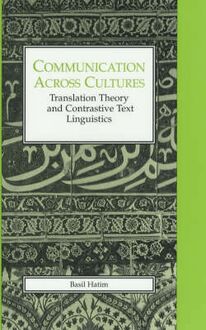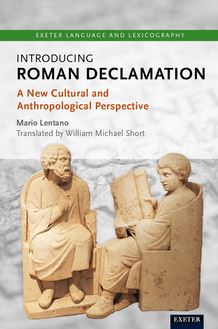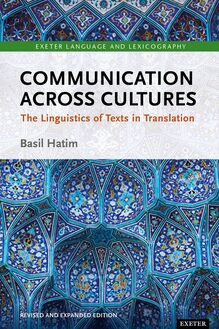Communication Across Cultures , livre ebook
167
pages
English
Ebooks
2020
Vous pourrez modifier la taille du texte de cet ouvrage
Obtenez un accès à la bibliothèque pour le consulter en ligne En savoir plus
Découvre YouScribe et accède à tout notre catalogue !
Découvre YouScribe et accède à tout notre catalogue !
167
pages
English
Ebooks
2020
Vous pourrez modifier la taille du texte de cet ouvrage
Obtenez un accès à la bibliothèque pour le consulter en ligne En savoir plus
Publié par
Date de parution
03 février 2020
Nombre de lectures
1
EAN13
9781905816323
Langue
English
Poids de l'ouvrage
1 Mo
A unique synthesis of contrastive linguistics and discourse analysis, providing a core text for upper undergraduates and postgraduates taking courses in language, applied linguistics, translation and cultural studies. The book will also be of interest to language teachers and other applied linguists, as well as translators and interpreters.
This revised and expanded edition includes important updates reflecting the growth over the past two decades in the theoretical study of translation and contrastive linguistics, and the wide-ranging practical applications of such studies. It offers authoritative updates on the major issues of translation and contrastive linguistics, using new practical examples and case studies that present the latest exploratory research of interest to both students and practitioners.
While English and Arabic remain the language pair used for illustrative purposes, the analytic tools and theoretical overviews presented are of global applicability. The main objectives pursued remain the training of future linguists and, more broadly, an increased awareness of the subtleties of discourse on the part of language users.
Preface (R R K Hartmann)
A New Introduction - Textual Rhetoric: The Missing Dimension
Translator decision-making informed by textual competence
Deeper text processing
The myth of the single register: a discourse perspective on linguistic variation
Argumentation: a contrastive text-type perspective
A model of argumentation from Arabic Rhetoric
Globalization, academic writing, translation: a new perspective on culture
Cultures within cultures: commodification discourse
On purpose
The status of the paragraph as a unit of text structure
Signalling background information in expository texts
On the interface between structure and texture: the textual progression of Themes and Rhemes
A text-type solution to a problem of texture: translating Cataphora
Degree of explicitness as a feature of texture
Emotiveness and its linguistic realization in texts
Translating direct and indirect speech and the dynamics of news reporting
A text-type perspective on the pragmatics of politeness
Cultures in contact and what people do with their texts: an applied- linguistic perspective
The discourse of alienation and its linguistic expression in a modern Arabic novella
The translation of irony: a discourse focus on Arabic
The other texts: implications for liaison Interpreting
References
Resources
Glossary of Terms in Contrastive Text Linguistics and Translation
Publié par
Date de parution
03 février 2020
EAN13
9781905816323
Langue
English
Poids de l'ouvrage
1 Mo
Communication Across Cultures
COMMUNICATION ACROSS CULTURES
The Linguistics of Texts in Translation
Basil Hatim
REVISED AND EXPANDED EDITION
First published in 2020 by
University of Exeter Press
Reed Hall, Streatham Drive
Exeter EX4 4QR
UK
www.exeterpress.co.uk
Basil Hatim 2020
The right of Basil Hatim to be identified as author of this
work has been asserted by him in accordance with
the Copyright, Designs and Patents Acts 1988.
British Library Cataloguing in Publication Data
A catalogue record for this book is available
from the British Library.
ISBN 978-1-905816-30-9 (Hardback)
ISBN 978-1-905816-31-6 (Paperback)
ISBN 978-1-905816-32-3 (Epub)
ISBN 978-1-905816-33-0 (PDF)
Typeset in Meta Serif and Scala Sans
by BBR Design, Sheffield
Contents
List of Figures
Foreword by R.R.K. Hartmann
Arabic Transliteration System
A New Introduction: Textual Rhetoric-The Missing Dimension
1. Translator Decision-Making Informed by Textual Competence
2. Deeper Text Processing
3. The Myth of the Single Register: A Discourse Perspective on Linguistic Variation
4. Argumentation: A Contrastive Text-Type Perspective
5. A Model of Argumentation from Arabic Rhetoric
6. Globalization, Academic Writing, Translation: A New Perspective on Culture
7. Cultures within Cultures: Commodification Discourse
8. On Purpose
9. The Status of the Paragraph as a Unit of Text Structure
10. Signalling Background Information in Expository Texts
11. On the Interface Between Structure and Texture: The Textual Progression of Themes and Rhemes
12. A Text-Type Solution to a Problem of Texture: Translating Cataphora
13. Degree of Explicitness as a Distinctive Feature of Texture
14. Emotiveness and Its Linguistic Realization in Texts
15. Translating Direct and Indirect Speech and the Dynamics of News Reporting
16. A Text-Type Perspective on the Pragmatics of Politeness
17. Cultures in Contact and What People Do with Their Texts: An Applied-Linguistic Perspective
18. The Discourse of Alienation and Its Linguistic Realization in a Modern Arabic Novella
19. The Translation of Irony: A Discourse Focus on Arabic
20. The Other Texts: Implications for Liaison Interpreting
Glossary of Contrastive Text: Linguistics and Translation Terms
References
Index
Figures
1 Strands of text in context
1.1 Register membership
1.2 Register and beyond
1.3 The semiotic triad
2.1 Register macro-structure
2.2 Layers of interaction
2.3 The structure of the counter-argument
3.1 Tenor vs field and mode
3.2 The semiotics of field, mode and tenor
4.1 Basic text types
4.2 Order of preference of argumentation type, English and Arabic compared
6.1 Text in context
6.2 The semiotic triad
6.3 Register membership
7.1 From register to macro-functions I
7.2 From register to macro-functions II
7.3 The discourse-genre-text triad
8.1 A typology of context and purpose
9.1 The negotiation of text structure
10.1 Exposition
10.2 Add-on background information
10.3 Three levels of narration
10.4 Main and subordinate texts
11.1 Simple linear TP
11.2 TP with a continuous theme
11.3 The tone-setter and the scene-setter
12.1 Argumentation and exposition
12.2 Cataphora in argumentation
12.3 Cataphora in exposition
15.1 Text structure of Sample 1
15.2 Text-discourse-genre chain
16.1 From discourse to text forms
16.2 Text type, power and distance
20.1 Intertextual retrieval
Foreword
Both contrastive linguistics and text linguistics are now truly in their prime; witness the numerous conferences held on the subject in various parts of the world, and the numerous handbooks and textbooks filling up the shelves in every university library. However, the combination of the two perspectives (the contrastive and the textual), for which some of us have been pleading for many years (I suggested the term contrastive textology in 1980), and whose computational implementation is now feasible, is only just beginning. A further development, the application of contrastive text linguistics to translation studies, is long overdue.
Basil Hatim s book not only addresses all these issues and controversies, but exemplifies them through the prism of Arabic, a language that has enjoyed a long and distinguished rhetorical tradition, but not the benefit of much modern theoretical work. The author is well qualified to undertake this difficult but exciting task. Ever since the days of his Exeter PhD he has explored the relevance of contrastive discourse analysis to English-Arabic translation and demonstrated it in his practical teaching.
We are gratified to be able to present Dr Hatim s ideas in our Exeter Linguistic Studies in the hope that they will enrich the debate and aid instruction in a growing interdisciplinary field.
R.R.K. Hartmann
Exeter, October 1996
Arabic Transliteration System
Using material in Arabic has been kept to an absolute minimum, and English glosses are almost always provided. However, when it is felt that a particular form needs to be reproduced in the original, Arabic transliteration is used. The following system has been consistently employed:
Adapted from http://www.arabic-keyboard.org/arabic/arabic-transliteration.php .
A New Introduction: Textual Rhetoric-The Missing Dimension
While the literature on translation theory, contrastive linguistics or discourse 1 analysis has certainly grown enormously in the last fifty years or so, very few books have attempted to fuse the three perspectives together. This book seeks to establish such links and to explore areas of common interest in the theory and practice of intercultural communication. Tackling the problem from this angle, this work will essentially be following a trend captured succinctly in these words by Reinhard Hartmann as far back as the early 1980s: Doing discourse analysis without a contrastive base is as incomplete as doing contrastive analysis without a discourse base. Using translation as the go-between provides us with an appropriate framework within which the entire enterprise of languages in contact may usefully be dealt with.
A specific aim of this book is thus to argue that, in any act of linguistic mediation, a careful consideration of the changes which a given text invariably undergoes when transferred across linguistic and cultural boundaries is a sure way of finding out what actually goes on inside and around texts, not only with reference to the language pair in question, but generally in the broader context of textuality. To appreciate how entire systems of source language rhetorical and linguistic conventions are brought to bear on the act of textual transfer, and how norms and conventions of a given language are reconciled with their counterparts in another language and culture, the analysis of a process such as translation is illuminative because it is precisely in that process that we see what happens in moving from one text world to another. This is particularly the case when we are occupied not only with the mechanical, lower-level vagaries of the linguistic system but also, and to a greater extent, with higher-order considerations of language in use and text in context.
In the course of the unfolding argument, authentic data from written and spoken English (or Arabic, mostly in back-translation) is used to add clarity to theoretical insights gained from a variety of disciplines, 2 including cognitive linguistics, translation studies, contrastive rhetoric and critical discourse analysis. A model of text processing will be outlined, and each aspect of the model proposed will be related separately to a problem of language processing, in domains as varied as translator and interpreter training, cultural studies, literary criticism and language teaching. The training of future linguists, and the sensitization of language users in general to the realities of discourse, are some of the overall objectives which this book seeks to pursue.
The book starts with a model-building chapter, which outlines the text-processing approach proposed and sees this in terms of three basic categories: context , text structure and texture . Context is defined in terms of three main strands: communicative ( register -based), pragmatic ( speech act -based) and semiotic ( sign -based). Structure and texture, in turn, are seen from the vantage point of text type shown to be at the centre of contextual analysis. Schematically, strands of text in context may be represented as in Figure 1 .
Figure 1 Strands of text in context
Thus, following the initial chapter on translator decision-making informed by textual competence ( Ch. 1 ), several chapters are devoted to register theory and text typology, seen from the perspective of modern text linguistics and classical rhetoric ( Chs. 2 , 3 , 4 and 5 ). Three new chapters written specifically for this edition follow, one on globalization and translation, another on culture and commodification, and the third on the notion of purpose in translating and interpreting ( Chs. 6 , 7 and 8 ). Text structure occupies us next and two further chapters deal specifically with the compositional planning of texts ( Chs. 9 , 10 and 11 ). Texture, or the various devices which lend texts the quality of being cohesive and coherent , is the concern of the following chapters ( Chs. 12 , 13 and 14 ), which build on the analysis of compositional formats such as the paragraph.
Once the various components of the model have been covered, we cast the net wider in the five chapters that follow ( Chs. 15 - 19 ). Here, the general aim is to test out both theoretical and practical insights in various domains of language in social life. Text type and politeness , cultures in contact, the analysis and translation of ideology in literature, the analysis and translation of irony in non-fiction, and the oral mode of interpreting seen as a socio-textual act, are some of the issues tackled from the



